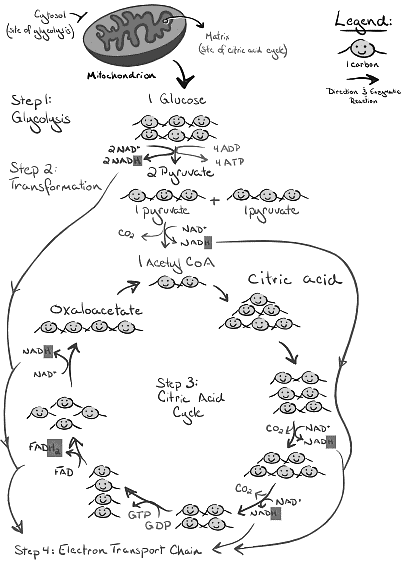MCAT Exam > MCAT Notes > Biochemistry for MCAT > The Citric Acid Cycle
The Citric Acid Cycle | Biochemistry for MCAT PDF Download
Introduction
The citric acid cycle, also known as the Krebs Cycle, is a crucial part of cellular respiration, which is the process by which the body extracts energy from the food we consume. It is interesting to note that the citric acid cycle derives its name from the presence of citric acid, which is found in citrus fruits like oranges.
- In the overall process of cellular respiration, the citric acid cycle occupies a specific place. It follows the initial step of glycolysis, which occurs in the cytosol and involves the breakdown of glucose, a simple sugar. The end product of glycolysis, pyruvate, then enters the mitochondria, where it is converted into acetyl CoA for further processing.
- The citric acid cycle takes place in the mitochondria and involves the modification of acetyl CoA. During this cycle, the acetyl CoA is gradually transformed, generating energy precursors as an outcome. These energy precursors play a crucial role in the subsequent step of cellular respiration.
- Following the citric acid cycle, the energy precursors produced are utilized in oxidative phosphorylation, which also occurs in the mitochondria. Oxidative phosphorylation involves the transfer of electrons derived from the energy precursors, leading to the phosphorylation of ADP and the production of ATP. ATP is a form of cellular energy that can be utilized by the body for various processes such as movement, respiration, heart function, and cognitive activities.
- Overall, the citric acid cycle plays a vital role in cellular respiration by capturing and processing the energy stored in the chemical bonds of acetyl CoA. This energy is then harnessed through oxidative phosphorylation to produce ATP, enabling the body to carry out its essential functions.
How does it happen?
To comprehend the functioning of the citric acid cycle, it is important to track the movement of carbon atoms as they enter and circulate within the cycle. These carbon atoms primarily constitute the molecules involved in the cycle. As the carbon atoms undergo stepwise rearrangements and carbon subtraction, energy is released. This energy is captured by specialized molecules known as electron shuttles.
- Electron shuttles serve as carriers of high-energy electrons, which are essential for various cellular processes. Examples of these electron shuttles include NAD+ and FADH. They facilitate the transport of electrons by undergoing a process called reduction, where they gain electrons, and oxidation, where they lose electrons. The electron shuttles play a crucial role in delivering the high-energy electrons to the appropriate locations within the cell.
- The transported electrons carried by these shuttles will ultimately be utilized to generate ATP, the energy currency of the cell. Hence, the electron shuttles act as intermediaries in the transfer of energy from the citric acid cycle to ATP production.
- In addition to understanding the rearrangement of carbons in the cycle, it is equally important to recognize the sites where high-energy molecules are synthesized. These molecules, which contain abundant energy, are produced during specific steps of the citric acid cycle. By identifying these key points, one can gain insight into the generation of essential energy-rich molecules within the cycle.
Let’s describe some of our key players in the citric acid cycle:
Energy shuttles:
- NADH is an important energy shuttle in cellular metabolism. It functions by delivering high-energy electrons to the electron transport chain, where they participate in the production of ATP. When NADH releases its electrons during this process, it becomes oxidized and transforms into its oxidized form, called NAD+. The oxidized NAD+ carries a positive charge.
- Similarly, FADH2 is another energy shuttle involved in the transport of high-energy electrons. It delivers these electrons to the electron transport chain, where they contribute to ATP production. When FADH2 loses its electrons, it undergoes oxidation and is converted back to its oxidized form, FAD.
- Both NADH and FADH2 play crucial roles in the electron transport chain, enabling the generation of ATP molecules. The high-energy electrons they carry are utilized to power the production of ATP, with NADH contributing to the synthesis of 2 to 3 ATP molecules and FADH2 driving the production of 1 to 2 ATP molecules.
High energy molecules:
- ATP serves as the fundamental energy currency of the cell. It is a molecule that carries and provides energy for various cellular processes. Cells can readily utilize the energy stored in ATP to perform essential functions such as muscle contraction, active transport, and synthesis of biomolecules.
- GTP, which stands for guanosine triphosphate, is a molecule closely related to ATP. It shares a similar structure and can be easily converted to ATP within the cell. GTP also functions as an energy carrier, participating in cellular processes where energy transfer is required. While ATP is more commonly used as an energy source in cells, GTP plays specific roles in certain biochemical reactions and serves as the primary energy source in processes such as protein synthesis and signal transduction.

Step 1: Glycolysis
- During the first step of cellular respiration, known as glycolysis, a 6-carbon glucose molecule undergoes a series of chemical reactions and is split into two 3-carbon molecules called pyruvates. Glycolysis occurs in the cytoplasm of the cell and does not require the presence of oxygen.
- The process of glycolysis involves the breakdown of glucose through a sequence of enzymatic reactions. Each glucose molecule is enzymatically converted into two molecules of glyceraldehyde-3-phosphate, and then further converted into two molecules of pyruvate. Along the way, several ATP molecules are generated, and high-energy electron carriers such as NADH are also produced.
Step 2: The transformation of pyruvate to acetyl CoA
- In the second step of cellular respiration, the pyruvate molecules produced during glycolysis undergo a transformation to generate acetyl CoA. This step serves as a bridge between glycolysis and the citric acid cycle, also known as the Krebs cycle.
- Each pyruvate molecule, which is a 3-carbon compound, undergoes a series of enzymatic reactions that result in the removal of one carbon atom, forming a 2-carbon molecule known as acetyl group. The carbon that is removed from pyruvate combines with two oxygen atoms from pyruvate to form carbon dioxide (CO2). This carbon dioxide is eventually released from the body as a waste product during exhalation.
- The conversion of pyruvate to acetyl CoA occurs within the mitochondria. The process involves the decarboxylation of pyruvate, where a carbon atom is removed in the form of CO2. The remaining two-carbon acetyl group then combines with coenzyme A (CoA) to form acetyl CoA.
- Acetyl CoA is a crucial molecule in cellular respiration as it serves as the primary fuel for the citric acid cycle. It enters the citric acid cycle and undergoes a series of chemical reactions, ultimately leading to the production of energy-rich molecules such as ATP, NADH, and FADH2.
Step 3: The citric acid cycle
The citric acid cycle, also known as the Krebs cycle or TCA cycle (tricarboxylic acid cycle), is a central metabolic pathway that takes place in the mitochondria of cells. It is called a cycle because the starting molecule, oxaloacetate, is regenerated at the end of the cycle, allowing the process to continue.
- The cycle begins with the fusion of acetyl CoA, a 2-carbon molecule derived from the breakdown of glucose or fatty acids, with oxaloacetate, a 4-carbon molecule. This fusion results in the formation of citric acid, a 6-carbon molecule, which gives the cycle its name. This reaction is catalyzed by an enzyme.
- Once citric acid is formed, a series of enzymatic reactions catalyzed by specific enzymes takes place. These reactions involve rearrangements of the carbon atoms in the molecule, resulting in the formation of different intermediate molecules. The enzymes involved in the cycle facilitate these rearrangements, increasing the rate at which they occur without altering the final outcome.
- During the citric acid cycle, carbon atoms are added to and removed from the starting molecule, oxaloacetate, through a series of chemical reactions. These reactions release energy in the form of electrons. Electron shuttles, such as NAD+ (nicotinamide adenine dinucleotide) and FAD (flavin adenine dinucleotide), play a crucial role in capturing this energy. They are reduced to NADH and FADH2, respectively, as the cycle progresses.
- The release of energy during the citric acid cycle occurs when certain steps in the cycle are energetically favorable. In these steps, the products of the reaction have lower energy than the reactants. The difference in energy between the products and the reactants is the energy that is released during the reaction. This released energy is captured by reducing NAD+ to NADH and FAD to FADH2.
Step 4: Oxidative phosphorylation
During oxidative phosphorylation, which is the final step of cellular respiration, the electron carriers NADH and FADH2, generated from previous steps such as glycolysis, the transformation of pyruvate to acetyl CoA, and the citric acid cycle, play a crucial role in generating ATP.
The document The Citric Acid Cycle | Biochemistry for MCAT is a part of the MCAT Course Biochemistry for MCAT.
All you need of MCAT at this link: MCAT
|
138 videos|21 docs|26 tests
|
Related Searches




















